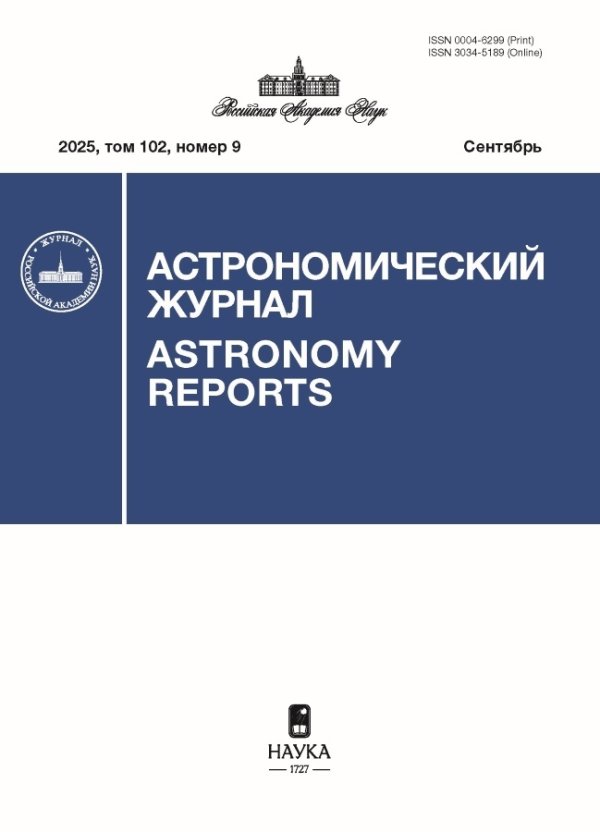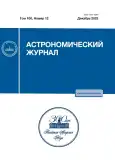PHYSICAL PROPERTIES AND KINEMATICS OF DENSE CORES ASSOCIATED WITH REGIONS OF MASSIVE STAR FORMATION FROM THE SOUTHERN SKY
- Authors: Pirogov L.E.1, Zemlyanukha P.M.1, Dombek E.M.1, Voronkov M.A.2
-
Affiliations:
- Federal Research Center Institute of Applied Physics of the Russian Academy of Sciences
- Commonwealth Scientific and Industrial Research Organisation (CSIRO) Space and Astronomy
- Issue: Vol 100, No 12 (2023)
- Pages: 1217-1244
- Section: Articles
- URL: https://rjsvd.com/0004-6299/article/view/647596
- DOI: https://doi.org/10.31857/S0004629923120071
- EDN: https://elibrary.ru/DDFKCK
- ID: 647596
Cite item
Abstract
The results of spectral observations in the \( \sim {\kern 1pt} 84{\kern 1pt} - {\kern 1pt} 92\) GHz frequency range of six objects from the southern sky having dense cores and associated with massive star and star cluster forming regions are presented. The observations are carried out with the MOPRA-22m radio telescope. Within the framework of the local thermodynamic equilibrium (LTE) approximation, column densities and abundances of the H13CN, H13CO+, HN13C, HC3N, c-C3H2, SiO, CH3C2H and CH3CN molecules are calculated. Kinetic temperatures (\( \sim 30{\kern 1pt} - {\kern 1pt} 50\) K), sizes of emission regions (\( \sim 0.2{\kern 1pt} - {\kern 1pt} 3.1\) pc) and virial mass esimates (\( \sim 70{\kern 1pt} - {\kern 1pt} 4600{\kern 1pt} {{M}_{ \odot }}\)) are obtained. The linewidths in the three cores decrease with increasing distance from the center. Four cores exhibit asymmetry in the profiles of the optically thick HCO+(1–0) and HCN(1–0) lines, indicating the presence of systematic motions in the line of sight. In two cases, the asymmetry can be caused by contraction of gas. The model HCO+(1–0) and H13CO+(1–0) spectral maps obtained within the non-LTE spherically symmetric model are fitted into observed ones. Radial density (\( \propto {\kern 1pt} {{r}^{{ - 1.6}}}\)), turbulent velocity (\( \propto {\kern 1pt} {{r}^{{ - 0.2}}}\)) and contraction velocity (\( \propto {\kern 1pt} {{r}^{{0.5}}}\)) profiles in the G268.42–0.85 core are obtained. The contraction velocity radial profile differs from expected both in the case of free fall of gas onto a protostar (\({{r}^{{ - 0.5}}}\)), and in the case of global core collapse (contraction velocity does not depend on distance). A discussion of the results obtained is provided.
Keywords
About the authors
L. E. Pirogov
Federal Research Center Institute of Applied Physics of the Russian Academy of Sciences
Author for correspondence.
Email: pirogov@appl.sci-nnov.ru
Russia, Moscow
P. M. Zemlyanukha
Federal Research Center Institute of Applied Physics of the Russian Academy of Sciences
Email: pirogov@appl.sci-nnov.ru
Russia, Moscow
E. M. Dombek
Federal Research Center Institute of Applied Physics of the Russian Academy of Sciences
Email: pirogov@appl.sci-nnov.ru
Russia, Moscow
M. A. Voronkov
Commonwealth Scientific and Industrial Research Organisation (CSIRO) Space and Astronomy
Email: pirogov@appl.sci-nnov.ru
Australia, Epping NSW
References
- J. C. Tan, M. T. Beltrán, P. Caselli, F. Fontani, A. Fuente, M. R. Krumholz, C. F. McKee, and A. Stolte, Protostars and Planets VI, edited by H. Beuther, R. S. Klessen, C. P. Dullemond, and T. Henning (Tucson: University of Arizona Press, 2014), p. 149.
- F. Motte, S. Bontemps, and F. Louvet, Ann. Rev. Astron. Astrophys. 56, 41 (2018).
- F. H. Shu, Astrophys. J. 214, 488 (1977).
- F. H. Shu, F. C. Adams, and S. Lizano, Ann. Rev. Astron. Astrophys. 25, 23 (1987).
- C. F. McKee and J. C. Tan, Astrophys. J. 585, 850 (2003).
- Y. Zhang and J. C. Tan, Astrophys. J. 853 (1), id. 18 (2018).
- E. Vázquez-Semadeni, A. Palau, J. Ballesteros-Paredes, G. C. Gómez, and Manuel Zamora-Avilés, Monthly Not. Roy. Astron. Soc. 490, 3061 (2019).
- R. B. Larson, Monthly Not. Roy. Astron. Soc. 145, 271 (1969).
- M. V. Penston, Monthly Not. Roy. Astron. Soc. 144, 425 (1969).
- R. Naranjo-Romero, E. Vázquez-Semadeni, and R. M. Loughnane, 814, 48 (2015).
- Л. Е. Пирогов, В. М. Шульга, И. И. Зинченко, П. М. Зем-лянуха, А. H. Патока, М. Томассон, Астрон. журн. 93 (10), 871 (2016).
- Л. Е. Пирогов, П. М. Землянуха, Астрон. журн. 98 (2), 102 (2021).
- I. Zinchenko, K. Mattila, and M. Toriseva, Astron. and Astrophys. Suppl. Ser. 111, 95 (1995).
- A. V. Lapinov, P. Schilke, M. Juvela, and I. I. Zinchenko, Astron. and Astrophys. 336, 1007 (1998).
- J. Harju, K. Lehtinen, R. S. Booth, and I. Zinchenko, Astron. and Astrophys. Suppl. Ser. 132, 211 (1998).
- I. Zinchenko, C. Henkel, and R. Q. Mao, Astron. and Astrophys. 361, 1079 (2000).
- L. Pirogov, I. Zinchenko, P. Caselli, L. E. B. Johansson, and P. C. Myers, Astron. and Astrophys. 405, 639 (2003).
- L. Pirogov, I. Zinchenko, P. Caselli, and L. E. B. Johansson, Astron. and Astrophys. 461, 523 (2007).
- T. Liu, K.-T. Kim, H. Yoo, S.-Y. Liu, et al., 829 (2), id. 59 (2016).
- Л. Е. Пирогов, Изв. ВУЗов. Радиофизика 64, 954 (2022).
- L. E. Pirogov, Astron. Rep. 53 (12), 1127 (2009).
- K. V. Getman, E. D. Feigelson, M. A. Kuhn, P. S. Broos, and G. P. Garmire, Astron. J. 158, id. 235 (2019).
- A. Roman-Lopes, Z. Abraham, R. Ortiz and A. Rodriguez-Ardila, Monthly Not. Roy. Astron. Soc. 394, 467 (2009).
- B. A. Binder and M. S. Povich, 864 (2), id. 136 (2018).
- D. A. Ladeyschikov, O. S. Bayandina, and A. M. Sobolev, Astron. J. 158, id. 233 (2019).
- D. Apai, H. Linz, T. Henning, and B. Stecklum, Astron. and Astrophys. 434, 987 (2005).
- C. D. Tremblay, T. L. Bourke, J. A. Green, J. M. Dickey, O. I. Wong, and T. J. Galvin, Monthly Not. Roy. Astron. Soc. 510, 593 (2022).
- J. S. Urquhart, M. G. Hoare, S. L. Lumsden, R. D. Oudmaijer, et al. Astron. and Astrophys. 507, 795 (2009).
- T. Culverhouse, P. Ade, J. Bock, M. Bowden, et al., Astrophys. J. Suppl. 195 (1), id. 8 (2011).
- S. L. Breen and S. P. Ellingsen, Monthly Not. Roy. Astron. Soc. 416, 178 (2011).
- J. L. Caswell, Publ. Astron. Soc. Australia 26, 454 (2009).
- M. A. Voronkov, J. L. Caswell, S. P. Ellingsen, J. A. Green, and S. L. Breen, Monthly Not. Roy. Astron. Soc. 439, 2584 (2014).
- S. L. Breen, Y. Contreras, J. R. Dawson, S. P. Ellingsen, M. A. Voronkov, and T. P. McCarthy, Monthly Not. Roy. Astron. Soc. 484, 5072 (2019).
- V. I. Slysh, S. V. Kalenskii, I. E. Val’tts, and R. Otrupcek, R. Monthly Not. Roy. Astron. Soc. 268, 464 (1994).
- I. E. Val’tts, S. P. Ellingsen, V. I. Slysh, S. V. Kalenskii, R. Otrupcek, and G. M. Larionov, Monthly Not. Roy. Astron. Soc. 317, 315 (2000).
- W. Yang, Y. Xu, X. Chen, S. P. Ellingsen, D. Lu, B. Ju, and Y. Li, Astrophys. J. Suppl. 231(2), id. 20 (2017).
- R. Ortiz, A. Roman-Lopes, and Z. Abraham, Astron. and Astrophys. 461, 949 (2007).
- B. Neichel, M. R. Samal, H. Plana, A. Zavagno, A. Bernard, and T. Fusco, Astron. and Astrophys. 576, id. A110 (2015).
- C. M. Dutra, E. Bica, J. Soares, and B. Barbuy, Astron. and Astrophys. 400, 533 (2003).
- J. L. Caswell, Monthly Not. Roy. Astron. Soc. 297, 215 (1998).
- S. L. Breen, J. L. Caswell, S. P. Ellingsen, and C. J. Phillips, Monthly Not. Roy. Astron. Soc. 406, 1487 (2010).
- M. J. Gaylard and G. C. MacLeod, Monthly Not. Roy. Astron. Soc. 262, 43 (1993).
- P. J. Barnes, S. D. Ryder, S. N. O’Dougherty, L. E. Alvarez, A. S. Delgado-Navarro, A. M. Hopkins, and J. C. Tan, Monthly Not. Roy. Astron. Soc. 432, 2231 (2013).
- C. Eswaraiah, S.-P. Lai, W.-P. Chen, A. K. Pandey, et al. 850(2), id. 195 (2017).
- S. L. Breen, S. P. Ellingsen, J. L. Caswell, J. A. Green, M. A. Voronkov, G. A. Fuller, L. J. Quinn, and A. Avison, Monthly Not. Roy. Astron. Soc. 426, 2189 (2012).
- A. J. Walsh, M. G. Burton, A. R. Hyland, and G. Robinson, Monthly Not. Roy. Astron. Soc. 301, 640 (1998).
- J. A. Green, J. L. Caswell, G. A. Fuller, A. Avison, et al., Monthly Not. Roy. Astron. Soc. 420, 3108 (2012).
- N. Ladd, C. Purcell, T. Wong, and S. Robertson, Publ. Astron. Soc. Australia 22 (1), 62 (2005).
- С. Ю. Малафеев, И. И. Зинченко, Л. Е. Пирогов, Л. Е. Б. Йоханссон, Письма в Астрон. журн. 31 (4), 262 (2005).
- А. В. Алакоз, С. В. Каленский, В. Г. Промыслов, Л. Е. Б. Юханссон, А. Виннберг, Астрон. журн. 79 (7), 610 (2002).
- E. Araya, P. Hofner, S. Kurtz, L. Bronfman, and S. DeDeo, Astrophys. J. Suppl. 157, 279 (2005).
- J. G. Mangum and Y. L. Shirley, Publ. Astron. Soc. Pacific 127, 266 (2015).
- S.-P. Lai, T. Velusamy, W. D. Langer, and T. B. H. Kuiper, Astron. J. 126, 311 (2003).
- F. Bertoldi and C. F. McKee, 395, 140 (1992).
- V. Camacho, E. Vázquez-Semadeni, A. Palau, G. Bus-quet, and M. Zamora-Aviles, 903(1), id. 46 (2020).
- P. Caselli, P. J. Benson, P. C. Myers, and M. Tafalla, 572, 238 (2002).
- T. G. Phillips, P. J. Huggins, P. G. Wannier, and N. Z. Scoville, 231, 720 (1979).
- N. J. Evans II, Ann. Rev. Astron. Astrophys. 37, 311 (1999).
- D. R. Flower, Monthly Not. Roy. Astron. Soc. 305, 651 (1999).
- C. R. Purcell, V. Minier, S. N. Longmore, P. Andre, et al., Astron. and Astrophys. 504, 139 (2009).
- Y. T. Yan, J. S. Zhang, C. Henkel, T. Mufakharov, et al., 877, id. 154 (2019).
- P. C. Myers, D. Mardones, M. Tafalla, J. P. Williams, and D. J. Wilner, 465, L133 (1996).
Supplementary files





















